Magnetic Resonance Center
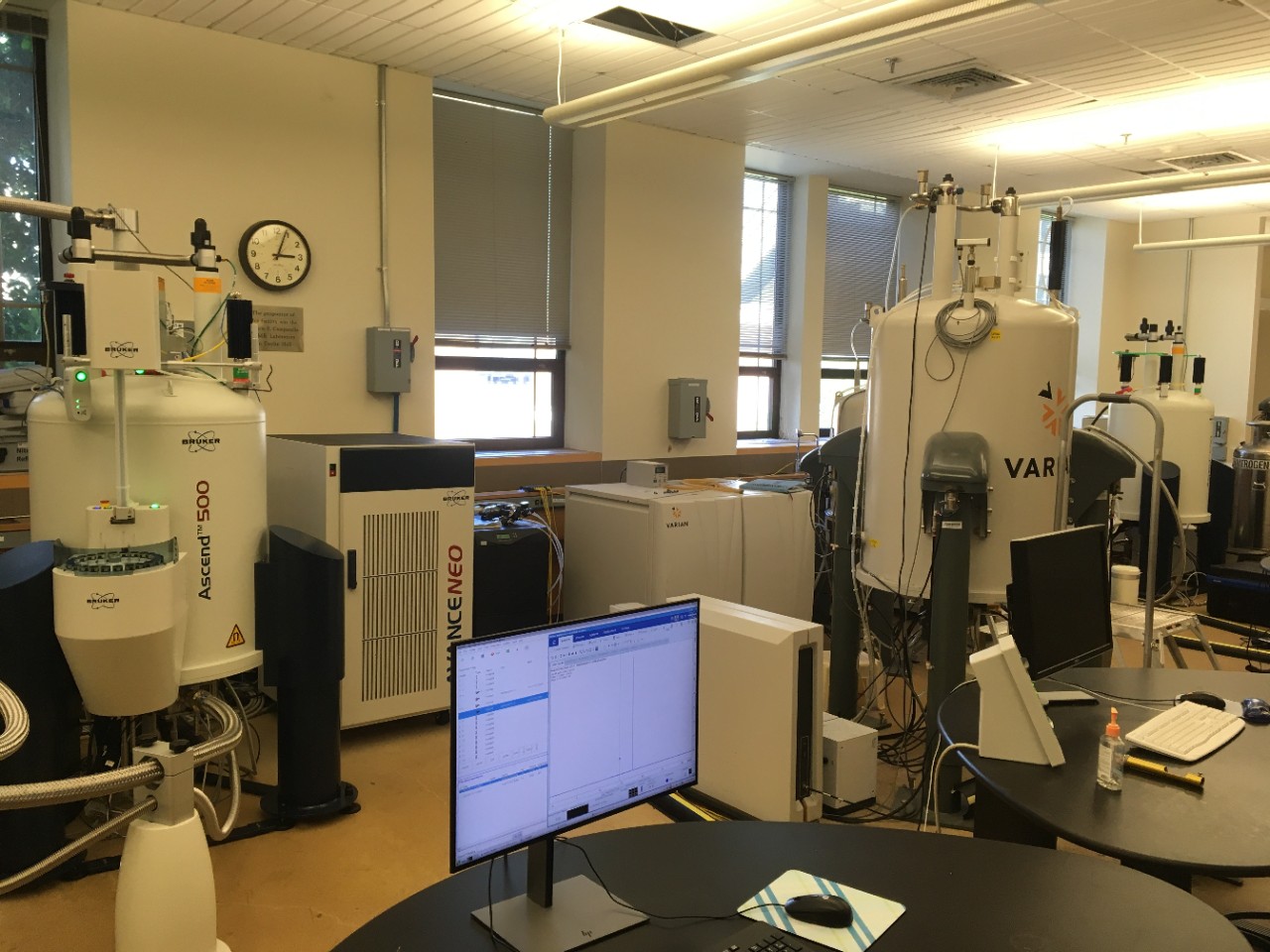
The Magnetic Resonance Center (MRC) at Boston College (BC) maintains three Varian/Agilent and two Bruker AVANCE NEO NMR spectrometers. The Varian/Agilent systems are at 400, 500 and 600 MHz with room temperature probes, while the two Bruker systems are at 500 MHz, and are equipped with helium and Prodigy CryoProbes. The Bruker instruments, which are the latest additions to the MRC, were funded by external grants from the NIH-S10 and NSF-MRI programs. In addition to the NMR spectrometers, the MRC also maintains a Bruker EMX-Plus EPR system with a cryogen-free variable temperature (VT) setup, as well as an ESR 5000 bench-top EPR spectrometer.
The instruments available at the MRC allow NMR users to observe most spin-active nuclei and perform nearly all state-of-the-art, multi-dimensional solution-state NMR experiments. Similarly, any required X-band EPR experiments can also be performed at ambient and low temperature settings, with MRC staff supervision. In addition to supporting the wide range of research programs of the BC faculty, these spectrometers are also used for teaching and outreach programs. The iLab Core Facility Management software is used for all reservation purposes, thereby ensuring the most efficient use of the facility’s resources.
In addition to the instrumentation and expertise of the MRC staff for consultations, all facility users are further supported by free access to the Mestrenova software for data processing, which can be utilized following a safe and seamless transfer of files to any personal device within the BC network. Users may also store data on the spectrometer computers; this data is backed up by the IT specialists at BC, who are always available to troubleshoot and resolve any technological issues.
BC Training Documents
Training Videos
Please note that all work performed in BC core facilities and recharge centers should always be appropriately acknowledged. If you are publishing or presenting data acquired in BC core facilities and recharge centers, please include the following statement in the Acknowledgement section of your manuscript/poster/presentation, "The authors would like to thank the Boston College <insert facility name> for assistance with the work presented in this paper/poster/presentation*."
* Delete as appropriate
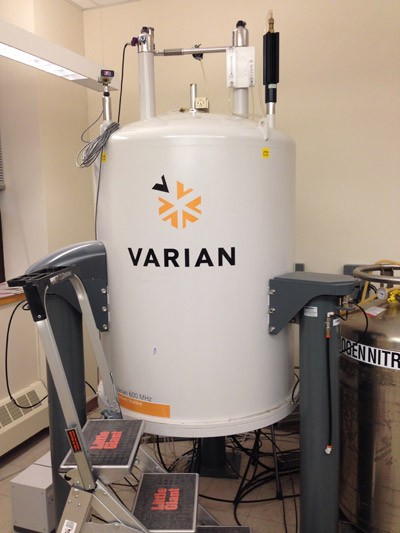
Manufactured by Varian NMR Inc. and including a 14.1 Tesla 54 mm bore Varian Premium Shielded long-hold magnet, the spectrometer is driven by a Dell OptiPlex 9010 computer running Linux Centos 6.10 and Agilent VJ 4.2 software. The 4-channel spectrometer (2 HB, LB and 2 LB) is equipped with a z-axis Performa IV pulsed field gradient, direct-drive architecture, ProTune automated tune and match for high and low-band probe channels, and variable temperature control.
The spectrometer has a 600 MHz 1H-19F/15N-31P PFG AutoX DB NB probe and a 600 MHz 1H{13C/15N} 5mm PFG automation-enabled triple-resonance probe.
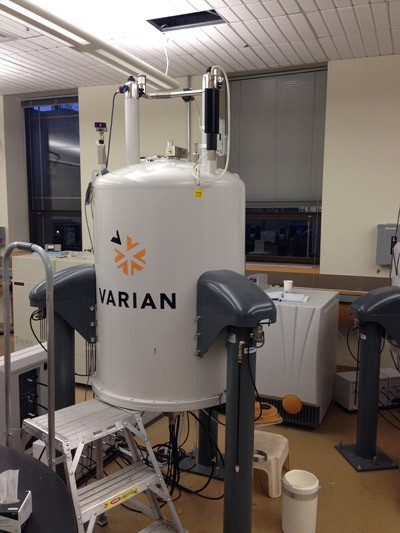
Manufactured by Varian NMR Inc. and including a 11.7 Tesla 54 mm bore Varian Premium Shielded long-hold magnet, the spectrometer is driven by a Dell OptiPlex 9010 computer running Linux Centos 6.10 and Agilent VJ 4.2 software. The dual channel spectrometer is equipped with a z-axis Performa IV pulsed field gradient, direct-drive architecture, ProTune automated tune and match for high and low-band probe channels, and variable temperature control.
The spectrometer has a 500 MHz1H-19F/15N-31P OneNMR PFG probe.
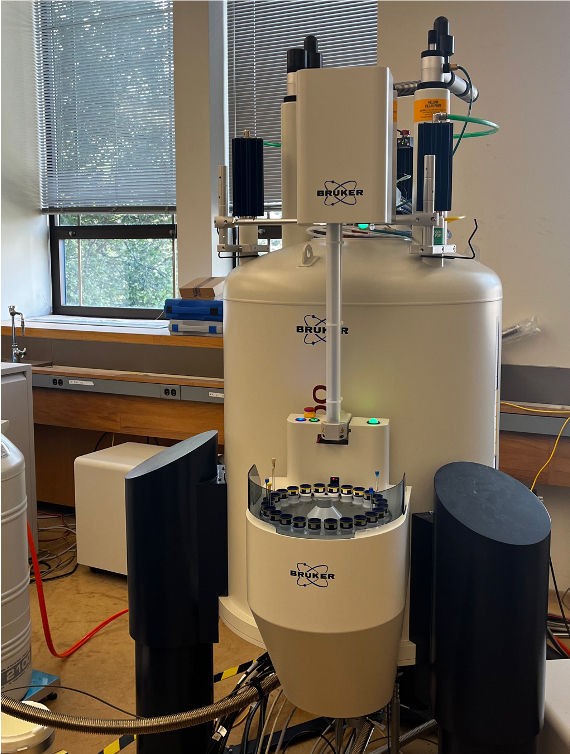
Manufactured by Bruker Inc., this AVANCE NEO 500 MHz spectrometer was supported by an award from the National Science Foundation Major Research Instrumentation (NSF-MRI) Program. The probe used on this system is an X nuclei optimized 5 mm double resonance BBO H&F CryoProbe Prodigy, which is designed for X-nuclei detection with 1H or 19F decoupling (or vice versa for 1H or 19F observation). The accompanying nitrogen VT gas separator and gas membrane air dryer allow users to easily run simple experiments at low temperatures up to -40 °C. Apart from research activities, this instrument will also be specifically used for a multitude of outreach programs at BC that are championed by the NSF. As of May 2025, the instrument has been upgraded with a sample case, and now operates on a hybrid manual/automated schedule during the day/night queues.
If this instrument was used for data collection that was later used in any publications, posters or presentations etc., please make sure to acknowledge the support from the NSF by citing the funding grant with the following statement: “The research reported in this [publication/poster/presentation] was supported by the National Science Foundation Major Research Instrumentation (NSF-MRI) Program, under the award number CHE-2117246.”
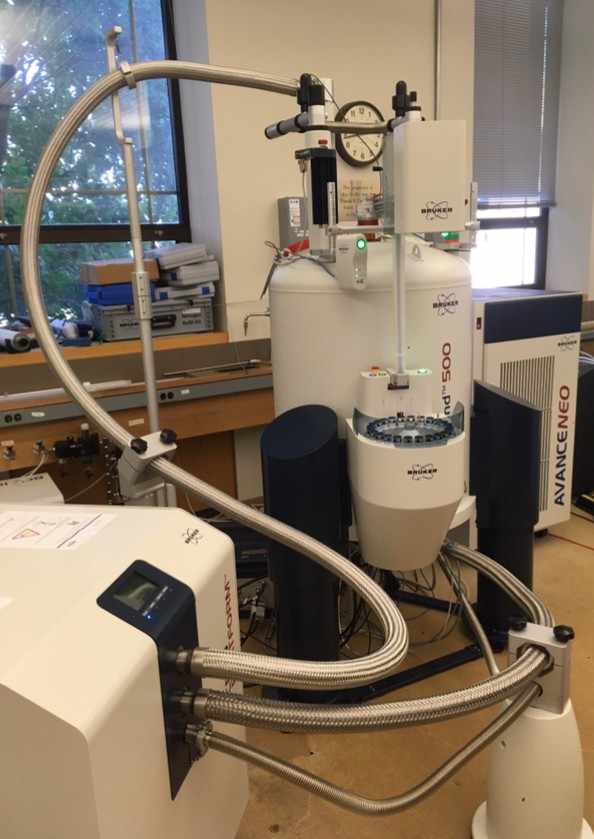
Manufactured by Bruker Inc., this AVANCE NEO 500 MHz spectrometer was supported by an award from the National Institutes of Health High-End Instrumentation (NIH-HEI S10) Program. The probe used on this system is CryoProbe (He) BBFO 5mm BBF/1H X nuclei optimized 5 mm double resonance BBFO (designed for X-nuclei observation with 1H decoupling and vice versa). The X nuclei range includes 19F, and the probe includes cooled preamplifiers for 1H, BBF and 2H. this highly sensitive system is primarily used to support the broad range of NIH-supported research programs at BC.
If this instrument was used for data collection that was later used in any publications, posters or presentations etc., please make sure to acknowledge the support from the NIH by citing the funding grant with the following statement: “The research reported in this [publication/talk/poster] was supported by the HEI-S10 Program of the National Institutes of Health, under the award number 1S10OD026910-01A1.”
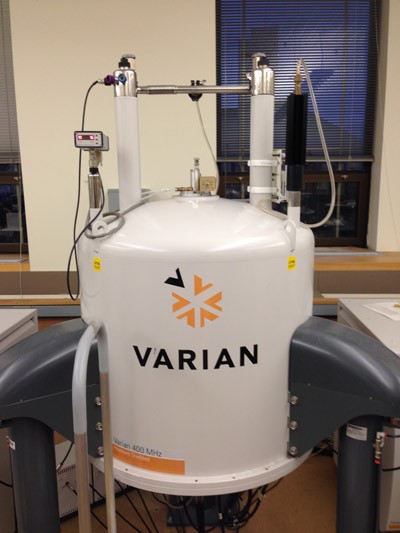
Manufactured by Varian NMR Inc. and including a 9.395 Tesla 54 mm bore Varian Premium Shielded long-hold magnet, the spectrometer is driven by a Dell OptiPlex 9010 computer running Linux Centos 6.10 and Agilent VJ 4.2 NMR software. The dual channel spectrometer is equipped with a z-axis Performa IV pulsed field gradient, direct-drive architecture, ProTune automated tune and match for high and low-band probe channels, and variable temperature control. The spectrometer has a 400 MHz1H-19F/15N-31P PFG AutoX DB NB probe.
The new departmental EMX-Plus EPR spectrometer from the Bruker Biospin Corporation is equipped with a cryogen free VT system that allows the samples to be cooled down to temperatures as low as 4.5 K. This instrument provides crucial support to research groups working on high-spin metal complexes containing iron or cobalt centers. Along with an ER 073 10” double-yoke magnet, this system has a Hall field controller and signal channel module that are both digital and ultra-high resolution, an X-band, solid state low noise microwave bridge and a high sensitivity probehead with an optical window for running CW-EPR experiments in X-band. The system runs on Xenon 1.1 acquisition software in a Linux environment, with WIN-EPR, WIM-SimFonia as well as the XSophe software package for the simulation of EPR spectra.
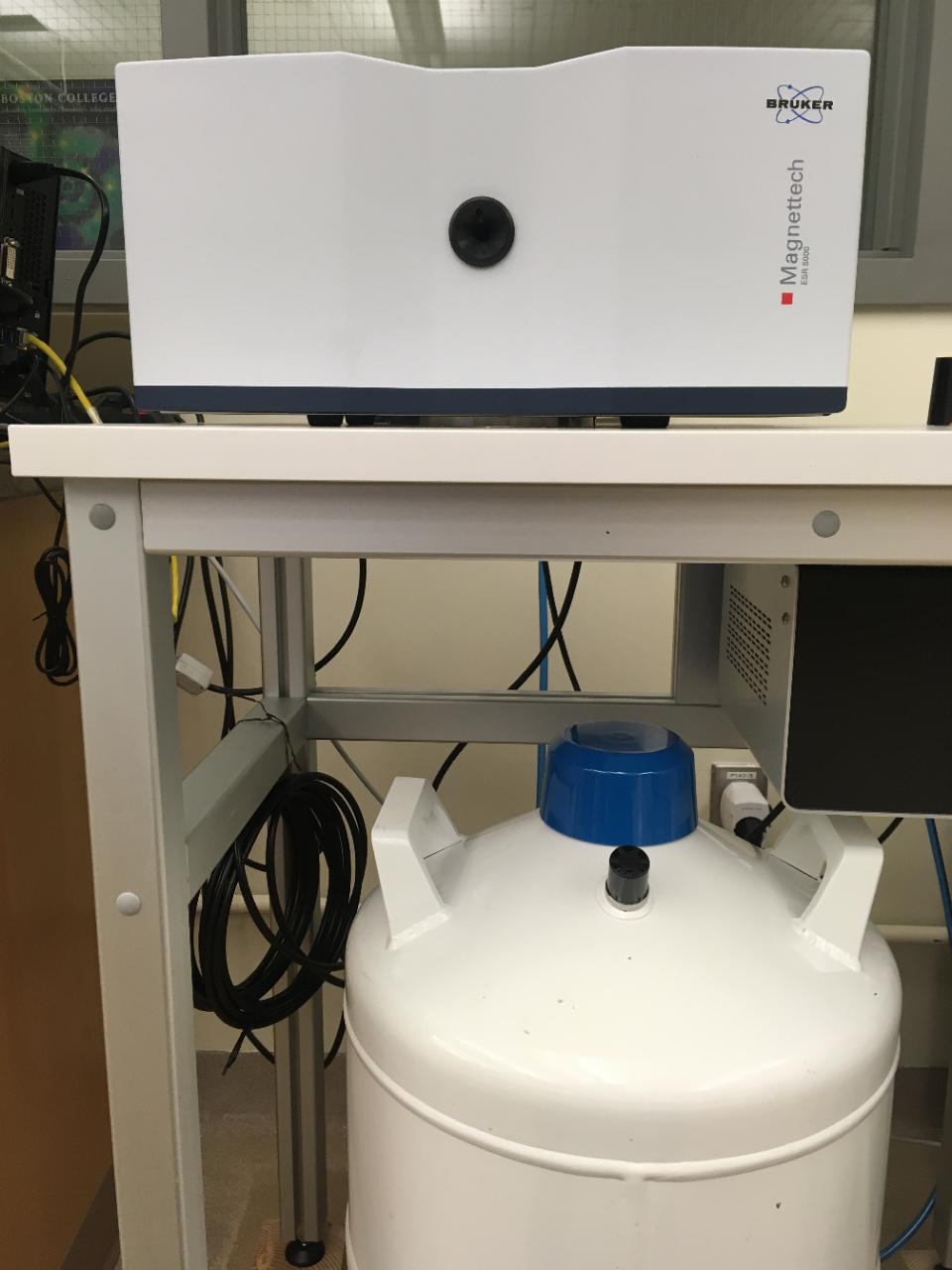
Manufactured by Bruker Inc., this ESR5000 X-band Bench-top CW EPR Spectrometer comes with a temperature control unit capable of running variable temperature experiments (using gaseous liquid nitrogen) covering the temperature range from -180 to 200 °C. This system is very helpful for acquiring simple EPR spectra, and for specific instances where a colder or warmer stable temperature is impossible to maintain on the EMX-Plus system, which is cooled using helium gas.

Thusitha Jayasundera, Ph.D.
Director, NMR Center
Dr. Jayasundera obtained his B.S. degree in Chemistry from UMass., followed by an M.S. and Ph.D. in Biophysical Chemistry from Yale University, as well as an M.B.A. from the Carroll School of Management at Boston College (BC). After completing two Postdoctoral Research Associate positions, the first at St. Jude Children’s Cancer Research Hospital and the next at Brown University, he joined the Chemistry Department at BC as the Assistant Director of the Magnetic Resonance Center (MRC) in August 2011, and took over the reigns as Director of the facility in 2016.
Dr. Jayasundera’s research training was focused on the multi-faceted field of protein NMR, including extensive dynamics and interaction studies between proteins and small molecules, as well as the three-dimensional structure determination of proteins using modern NMR methods. In addition to his duties at the MRC, he teaches two electives for the Chemistry Department (Principles and Applications of NMR in the Fall, and Magnetic Resonance in Biology in the Spring), as well as a course on Surviving Life with Humor for the University Capstone Program.
Magnetic Resonance Center
Thusitha Jayasundera, Ph.D.
Director
thusitha.jayasundera@bc.edu
617.552.6984
Merkert 105A
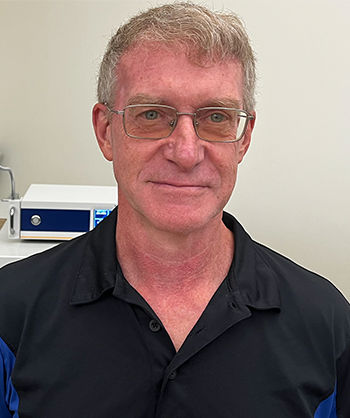
Charles Hanson, BSEE
Assistant Director
Mr. Charles Hanson joined the Magnetic Resonance Center at Boston College in the fall of 2025. He completed his education first at the Norwalk Technical College in Connecticut, and then at the Bridgeport Engineering Institute at Fairfield University. Chuck’s prolific career as an engineer culminated with a 26-year stint at Bruker in their Electron Paramagnetic Resonance (EPR) division. In fact, he was the lead engineer who installed both EPR spectrometers at the MRC at Boston College: the cryogen-free EMX-Plus system in 2017, and the ESR-5000 in 2021. Chuck brings with him a wealth of expertise and technological know-how to our Core facility; his experienced technical and hands-on capabilities at diagnosing and solving a myriad of issues in magnetic resonance instrumentation would allow us to complete most required repairs and maintenance in-house, saving much time and allaying anxieties.
Magnetic Resonance Center
Charles Hanson, BSEE
Assistant Director
charles.hanson@bc.edu
617.552.6984
Merkert 107

